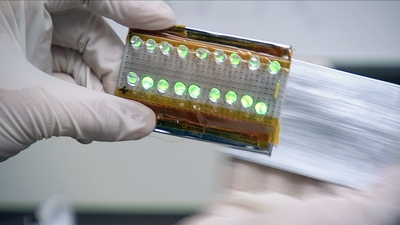Harvesting mechanical energy from the triboelectric effect
Researchers at the Georgia Institute of Technology (Georgia Tech) have discovered how to create significant amounts of electric power by rubbing or touching two different materials together - a phenomenon known as the triboelectric effect.
Professor Zhong Lin Wang and his team in the School of Materials Science and Engineering have invented a triboelectric nanogenerator to harvest the energy created from otherwise wasted mechanical energy. “Mechanical energy is everywhere,” said Wang, “independent of weather, independent of day or night, independent of season.”
In its simplest form, the generator uses two sheets of dissimilar materials - one an electron donor, the other an electron acceptor. The device generates energy in two basic modes: contact mode and sliding mode.

In contact mode, when the materials are in contact, electrons flow from one to the other. If the sheets are then separated, one sheet holds an electrical charge isolated by the gap between them. If an electrical load is then connected to two electrodes placed at the outer edges of the two surfaces, a small current will flow to equalise the charges. By continuously repeating the process, an alternating current can be produced. In sliding mode, the materials - most commonly inexpensive, flexible polymers - produce current if they are rubbed together before being separated.
“The fact that an electric charge can be produced through triboelectrification is well known,” Wang said. “What we have introduced is a gap separation technique that produces a voltage drop, which leads to a current flow in the external load, allowing the charge to be used.” The generator can thus convert random mechanical energy from the environment into electric energy.
When Wang and his team first invented the technology in 2011, the output was 3 volts. “Today,” Wang said, “our best can be 10,000 volts.”
The technique is already “able to deliver small amounts of portable power for today’s mobile and sensor applications”, said Wang. He is also using the triboelectric effect for sensing without an external power source; as the generators produce current when they are perturbed, they could be used to measure changes in flow rates, sudden movement or falling raindrops.
“If a mechanical force is applied to these generators, they will produce an electrical current and voltage,” he said. “We can measure that current and voltage as electrical signals to determine the extent of the mechanical agitation. Such sensors could be used for monitoring in traffic, security, environmental science, healthcare and infrastructure applications.”
Furthermore, the range of energy-gathering techniques has expanded to include ‘power shirts’ containing pockets of the generating material, shoe inserts, whistles, foot pedals, floor mats, backpacks and floats bobbing on ocean waves.
The researchers are continuing to study how to increase the generator’s output and sensitivity. “It’s very simple,” said Wang, “and there is much more we can do with this.”
Electronex expo returns to Sydney in 2026
Following the success of Melbourne's Electronex expo, the launch of Electronex 2026 in Sydney...
Electronex Sydney a major success
More than 1000 trade visitors and delegates have attended the Electronics Design & Assembly...
Gartner: Global AI chips revenue to grow 33% in 2024
Gartner has forecast that the revenue from AI semiconductors globally will total $71 billion in...





